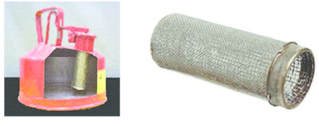Safety cans are equipped with three distinct accessories that are designed to protect the user from explosive vapors that may escape while in storage or even during use.
OSHA’s definition of a safety can includes those three accessories –
“Safety can means an approved closed container, having a flash-arresting screen, spring-closing lid and spout cover and so designed that it will safely relieve internal pressure when subjected to fire exposure.”
The flash-arresting screen or flame arrestor is a perforated metal screen that allows liquid to pour through. The purpose of this screen is to absorb and dissipate any heat or flame introduced outside of the container so that it will not ignite the vapor on the inside of the container. Think of the flame arrestor like the screen in front of your fireplace; it doesn’t allow sparks to pass through from either side.
They are also equipped with a spring-loaded cap that closes the spout automatically when released. Tension in the spring forces the cap closed and provides a leak-proof seal. The spring tension is also designed to lift the cap slightly in the event of excessive internal vapor pressure inside the can. This automatically vents off vapors at approximately 5PSI internal pressure, to prevent the can from rupturing or exploding if it is exposed to excessive outside heat.
Think About It: There are many instances where plastic “consumer” gas cans exploded while the victims were simply walking with the can. The movement or flow of gasoline creates an electrical charge that will create a spark when it discharges and cause the vapor to explode.


 RSS Feed
RSS Feed
